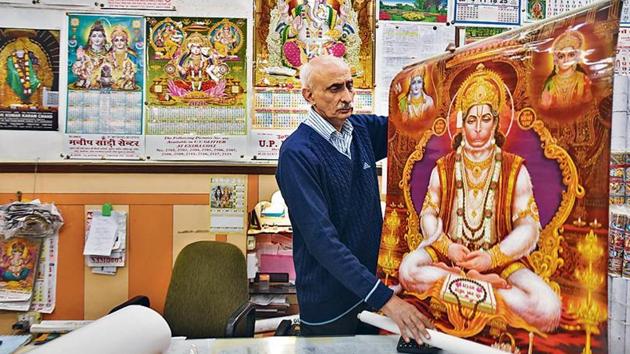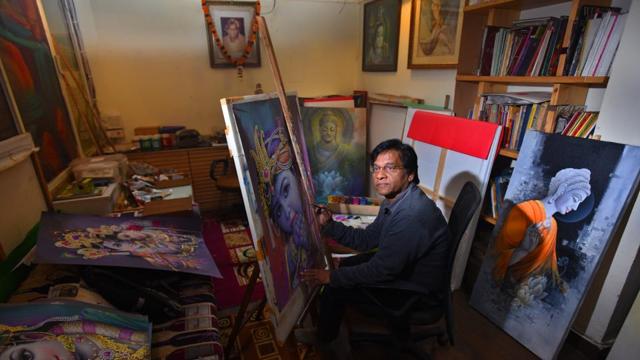Calendar art continues to thrive in digital age
Calendars featuring gods and goddesses are being printed and sold in the millions, even though the tribe of calendar artists is dwindling.
Ranjeet Singh is applying finishing touches to a Lord Krishna painting in his tastefully done studio in west Delhi’s Moti Nagar. With him are a galaxy of gods —Shiva, Ganesha, Vishnu, the Buddha, all painted by him and his brother. Set up in 1951 by his artist father and uncle, the studio “Rangroop”, is known for its calendar art.

“Many people think that calendar art is dead, but the fact is my hands are full,” says Singh.
He is not exaggerating. Calendars with images from Hindu mythology, an essential part of India’s visual culture, continue to thrive even in the digital age. In fact, top traders and manufacturers in Delhi say the sales of wall calendars remains steady with some even reporting an increase in the past few years.
“My business is growing by 15 percent a year. We supply calendars to 92 cities across the country, including all metros,” says Abhinav Jain, proprietor of Jain Art Press, a leading manufacturer of calendars for the last 50 years at Nai Sarak, a hub for calendar companies in Delhi.
Gulshan Khetarpal, who runs Sunshine Enterprises, another leading calendar company at Nai Sarak, said, “Only yesterday, I printed about 500,000 calendars for a cement company in Rajasthan. In fact, unlike in the past, now we print calendars in many different sizes.”
At wholesale, the cheapest, a pocket calendar, in his shop is priced at 20 paisa while the costliest, a jumbo calendar (33x56 inch) costs ₹60.
No wonder then that paper calendars have continued to be the cheapest and an effective means of advertising for businesses of all sizes — a way for brands to make and maintain their social and commercial connections since the early 20th century.
Giving God a face
Raja Ravi Varma, known as the father of Indian calendar art, was the first Indian artist to give a face to Hindu gods and goddesses on canvas. Till then, they had only been depicted as sculptures in temples.
Many of Verma’s famous paintings — Goddess Laxmi floating on a lotus in full bloom; an erudite Saraswati playing the veena, among others — are said to have been modelled on his relatives and the people around him.
In 1894, he set up, with the help of a German technician Fritz Schleicher, his own printing press in Mumbai, which churned out oleographs of his realistic paintings, bringing images from Hindu mythology into the houses of common people.
Over the next few decades, the other presses came up in cities such as Pune, Kolkata, and Sivakasi, which in their early days mostly printed calendars with mythological figures, giving rise to what came to be known as calendar art or bazaar art.
In the 1920s and 1930s, brands such Sunlight Soaps, Woodwards gripe water, British Alizarine Company brought out calendars featuring art of Raja Ravi Varma. Later, Vasudev H Pandya, who was known for his Krishna paintings, was commissioned by many brands for calendar art.
In the 1940s and 60s, artists such as SM Pandit, K Madhavan, Raghuvir Mulgaonkar, BG Sharma made their mark in the sphere of calendar art; P.Sardar, JP Singhal, Indra Sharma, Yogendra Rastogi, were among the most sought calendar artists in the 1970 and 80s.

Like most calendar artists, JP Singhal was a self-taught artist with a vast oeuvre that included hyper-real depictions of gods and goddesses, tribal women and idyllic village scenes. JP Singhal’s son and fashion designer Dinesh Singhal says of his father, “Calendar publishers had to pre-pay him three years in advance. He charged as much as ₹5 lakh for some calendar paintings.
Many calendar artists — most worked outside the mainstream art scene — started their own studios: Studio SM Pandit and Mukgaonkar Art Studio in Mumbai, Rangroop studio in Delhi— where they collaborated with fellow artists. Until the 1990s, there were several studios in cities such as Mumbai, Kolkata, Chennai Sivakasi, Nathdwara, and Meerut, which was once home to several artists including Yogendra Rastogi and JP Singhal, who later moved to Mumbai.
Challenges of portrayal
Calendar artists say portraying god is a challenge.
“After all, I have to ensure the god must look gentle, beautiful, tranquil, and benevolent; and that their beauty is truly divine,” says Ranjeet Singh of Rangroop studio in Delhi. His father Ram Singh and uncle Babu Singh were much sought after calendar artists during the 1970-80s.
Many of these artists have been painting the same mythological figures all their lives, so how do they bring freshness to their work and maintain some novelty?
“I try to change the pose, gaze, dress and shringar (adornments) of the gods and goddesses. There is not much I can do; I have to keep the taste and sensibilities of the customer in mind,” says Singh, whose studio produces about eight calendar paintings a month these days. He also has a studio in Kodaikanal in Tamil Nadu where he works from May to September.
VV Sapar, a celebrated artist who has been commissioned by several international organisations for conceptual paintings on religion, culture and spirituality, has a different take. “The problem is that calendar artists have portrayed gods and goddesses in the same way over the decades, and it has to do with the mindset of people who would not want a dancing Ganesha, but only the Ganesha sitting on a throne. So artists have been afraid to experiment with calendar art,” he says. His father Vishnu Sapar, 85, now retired, is a well-known calendar artist. “I am lucky that my clients have given me the freedom to visualise gods in my own way. I have painted Krishna as a friend, a protector, a lover, Guru in different styles.”
So, what does it take to paint gods and goddesses? “First and foremost you have to have a spiritual bent of mind, and have to have faith in god,” says Sapar.
Tech and Calendar art

Many artists say that computers and software such as Photoshop have adversely affected their art even as the demand for calendars remains high.
Prakash Chandra Gilotra, who runs Subhash Calendar Co in Delhi’s Nai Sarak, which has been in the business since 1971, says he has over 2,000 original calendar paintings in his collection and does not commission many new calendar paintings. “Very few artists are left,” says Gilotra, sitting inside his first floor shop whose walls are adorned with calendars of various sizes, all featuring gods and goddess.
His view is supported by M L Garg, managing director, Brjbasi Art Press, one of the country’s biggest calendar companies for almost a century now. “We still print millions of calendars every year; they are as popular as ever in smaller towns. But most top calendar artists who worked for us are no more. Now we use old paintings with some changes by our in-house team of digital artists,” says Garg.
A lot of young artists, Sapar says, do not want to get into calendar art because they feel it does not provide any scope for creativity. “Besides, publishers do not want to invest in art and pay royalties to artists on the sales of calendars featuring their artworks,” he says.
Collector’s item
The original calendar art and calendars are fast becoming collectibles. An online platform Kalakriti sells original paintings by celebrated calendar artists. “We have over 2000 original calendar works by top notch artists; and 200 calendars– printed between 1910 and 1980s. Among the buyers are businessman, researchers and collectors,” says Rahul Rajora, its founder.
The works of calendar artists like SM Pandit, C Kondiah Raju, fetch anything between ₹2 lakh to 2.5 lakh. “I collected most of them from calendar publishers and printing presses from all over the country,” says Rajora. “The government should take steps to preserve their artwork, which are an important part of our country’s mass culture.”
Back at Subhash Calendar Co at Nai Sarak, as we talk to Gilotra, a customer asks 5000 calendars featuring Ram Darbar. Gilotra check his stock, puts up his price, and the order is fulfilled within minutes. Another customer from Bihar comes in and asks for 10,000 Krishna calendar. “You see, a calendar has both religious and ornamental significance. It will never be outdated,” says Gilotra.
Stay updated with all top Cities including, Bengaluru, Delhi, Mumbai and more across India. Stay informed on the latest happenings in World News along with Delhi Election 2025 and Delhi Election Result 2025 Live, New Delhi Election Result Live, Kalkaji Election Result Live at Hindustan Times.
Stay updated with all top Cities including, Bengaluru, Delhi, Mumbai and more across India. Stay informed on the latest happenings in World News along with Delhi Election 2025 and Delhi Election Result 2025 Live, New Delhi Election Result Live, Kalkaji Election Result Live at Hindustan Times.






